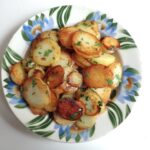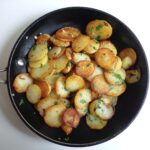
There are four key ingredients in these melt-in-the-mouth, intensely garlicky, skillet-fried potatoes from southwest France — the potatoes, the garlic, parsley and duck or goose fat. As duck fat may not be available to all readers, my question was, how would the dish be without it? The answer was: almost as spectacular. Which is why I am offering the original and an alternative version of this classic, which marries well with just about anything.
Pommes de terre sarladaises / Skillet-fried potatoes with garlic and parsley
Pommes de terre sarladaises (pronounced sahr-lah-DEHZ) take their name from the pretty town of Sarlat-la-Canéda in Dordogne. Farms in the surrounding area raise ducks and geese, which star in the local cuisine in the form of confits (preserved duck or goose), foie gras and cassoulet (a bean stew that I plan to write about in due course). Sarlat has a bustling farmers market throughout the year, and over the winter it also hosts a marché au gras, where fatted fowl and their products are sold according to ancient custom.
Among the products sold are duck and goose fat in jars or cans, which simplifies matters if you’d like to make Sarladaise potatoes the authentic way. These days duck fat is also available in stores throughout France and online in the States, Britain and many other countries. However, I have never purchased this product, as I prefer to make my own.
Rendering duck fat is easier than you may think, providing you cook duck once in a while. For example, if you’re preparing a magret de canard (duck breast), you can pour off the fat into a recipient as it cooks, then strain it through a sieve into a clean jar. Once it cools you can refrigerate the duck fat, which will keep for months. You can add to the jar over and over, and use the fat as needed for cooking — well, I mainly use it for Sarladaise potatoes.
Lacking duck fat, you can fry the potatoes in a combination of butter and oil.
For success with whatever version you choose, here are some tips. First, don’t be tempted to accelerate preparation by steaming or parboiling the potato slices before frying — they need to be fried raw (à cru) to achieve the crispy exterior and meltingly tender interior. Second, wait until the potatoes are golden and ready to serve before adding the garlic. The minced raw garlic is what produces the delightful pungency of these potatoes.
 If you’d like to try your hand at rendering duck fat, you could start out with one of these recipes: magret de canard au cassis (duck breast in a black currant sauce), salade thaïe au magret (Thai-style salad topped with sliced duck breast) or canard rôti au miel et au thym (roast duck with honey and thyme). Each recipe will produce about half a jar of duck fat — more than enough for frying up a panful Sarladaise potatoes.
If you’d like to try your hand at rendering duck fat, you could start out with one of these recipes: magret de canard au cassis (duck breast in a black currant sauce), salade thaïe au magret (Thai-style salad topped with sliced duck breast) or canard rôti au miel et au thym (roast duck with honey and thyme). Each recipe will produce about half a jar of duck fat — more than enough for frying up a panful Sarladaise potatoes.
Happy cooking.




